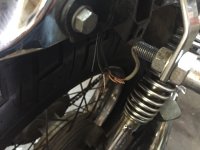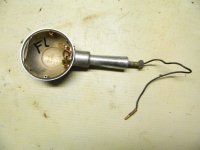sincerelyadam
Active Member
Hi everyone.
I'm a new member. Been reading a lot, but this is my first post. So, Hi!
I have a wiring question regarding the starter and right rear turn signal. I recently purchased a 1980 Yamaha SR250. Great bike! The electric start worked great, I made a few changes to the bike and now the electric start doesn't work, like totally dead. No sound at all. But it does dim the headlight when I press the button. Here's where I am to date...
Changed the handlebars from chrome to painted black. I learned online that the ground in the starter switch presses against the handlebar, so I filed the paint off the bar in the area where the ground contacts it. Still no start. Filed the paint from the handlebar where it contacts the riser. Still no start. So I've eliminated the ground in the starter switch as the problem.
Which leaves me with the right rear turn signal. The only other piece of electrical that I've touched. I removed the sissy bar from the bike, which shared a mounting point with the signals, so I removed them as well. Something seems weird about the wiring here. Each signal has only one wire coming out of them, and from what I've seen online most have two. From the bike there is one wire going to the left rear signal, and two going to the right rear, plus a very tiny blue one. In the pic you can see I have two wires touching, dark green and signal wire. This causes the signal to blink as normal. And then there's a black wire hanging, and that tiny blue one, that I don't know what to do with. Both signals are working fine, but not the starter.
So is this "extra" wire that's hanging there somehow related to the starter? Like the circuit isn't closed or something. Or maybe it's not related at all and I'm missing something else entirely? My electrical knowledge is limited so laymen's terms are appreciated.
Thanks!
I'm a new member. Been reading a lot, but this is my first post. So, Hi!
I have a wiring question regarding the starter and right rear turn signal. I recently purchased a 1980 Yamaha SR250. Great bike! The electric start worked great, I made a few changes to the bike and now the electric start doesn't work, like totally dead. No sound at all. But it does dim the headlight when I press the button. Here's where I am to date...
Changed the handlebars from chrome to painted black. I learned online that the ground in the starter switch presses against the handlebar, so I filed the paint off the bar in the area where the ground contacts it. Still no start. Filed the paint from the handlebar where it contacts the riser. Still no start. So I've eliminated the ground in the starter switch as the problem.
Which leaves me with the right rear turn signal. The only other piece of electrical that I've touched. I removed the sissy bar from the bike, which shared a mounting point with the signals, so I removed them as well. Something seems weird about the wiring here. Each signal has only one wire coming out of them, and from what I've seen online most have two. From the bike there is one wire going to the left rear signal, and two going to the right rear, plus a very tiny blue one. In the pic you can see I have two wires touching, dark green and signal wire. This causes the signal to blink as normal. And then there's a black wire hanging, and that tiny blue one, that I don't know what to do with. Both signals are working fine, but not the starter.
So is this "extra" wire that's hanging there somehow related to the starter? Like the circuit isn't closed or something. Or maybe it's not related at all and I'm missing something else entirely? My electrical knowledge is limited so laymen's terms are appreciated.
Thanks!













